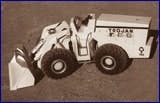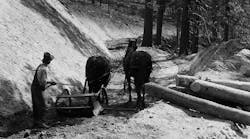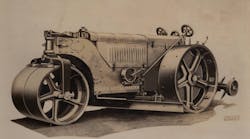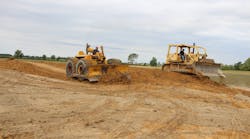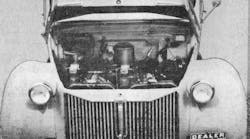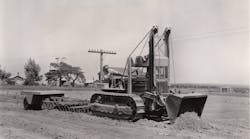Wheel loaders started out in the 1920s as small-capacity farm tractors with bucket attachments on the front. Next came larger four-wheel-drive models designed from the ground up as productive loaders, but they were hampered by inflexible non-pivoting rigid frames that resulted in large turning circles restricting their movement in tight places. These shortcomings were remedied by the advent of articulated or center-pivot steer loaders that began to appear in the late 1950s with obvious advantages. By the mid-1960s, all the leading wheel-loader manufacturers offered articulated models in their lines and this type became standard in the industry.
One of the last to change to articulation was Yale & Towne Manufacturing Co. of Batavia, New York, who had been building the well-respected Trojan brand since 1950. When Yale decided to produce an articulated loader, it did so in style: The first machine boasted dual-articulation with two pivots instead of one! Launched in 1966, the huge Trojan 8000 carried a standard bucket of 8 cubic yards and boasted an operating weight of 52 tons. The company said, "dual pivot design provides the speed and maneuverability of a conventional articulated machine, yet possesses all the stability of a rigid-frame construction. This is achieved by the six-ton center section acting as a laterally-sliding counterweight, shifting its weight to the outside on every turn as it balanced the raised bucket." And further, "the three-sectioned machine configuration provides maintenance personnel with unprecedented access to the machine for servicing and inspection through the two large "walk-in" openings available when the machine is parked in its fully articulated position."
The loader was offered with GM or Cummins 12-cylinder diesels in the 480-flywheel-hp class. The four wheels were driven by a full-reversing, four-speed power shift transmission with torque converter. Variable-rate steering provided 40-degrees articulation in each direction. Other features included servo controls for the bucket and boom, and a "demand hydraulic" system that automatically switched hydraulic power to the steering or to the bucket as needed. Although achieving a production life of only three years, it was Yale's biggest wheel loader.
Yale earned an excellent reputation for a long line of successful loaders. From its first — the LM-75 in 1950 — Yale enjoyed success with an extensive line of rigid-frame models and, after the big 8000, more articulated models were introduced and upgraded through the 1970s. In 1982, Faun AG from Germany took over Yale & Towne Manufacturing and merged the machines into the Faun line of wheel loaders. In 1986, O&K (Orenstein & Koppel) of Germany took over the Faun company along with the wheel loaders and continued their production at Batavia, New York. The Trojan loaders were discontinued in 1992 when the Batavia plant closed.
Read more about earthmoving machines in Keith Haddock's books "Giant Earthmovers" and "Colossal Earthmovers."

